
HOW-TO:
SEO
SEO - Search Engine Optimization Guide for B2B
Would you like to gain an overview of SEO? Finally know exactly what, how and why?
Then you've come to the right place! On this page, we have compiled a comprehensive overview of all aspects of search engine optimization.
The following topics await you:
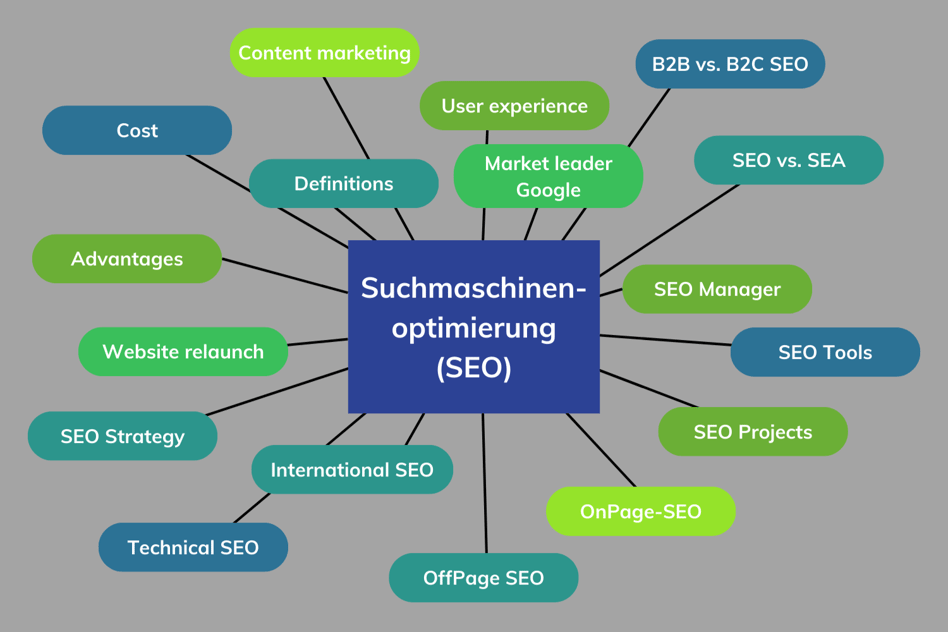
The SEO guide is aimed at everyone in the company who wants to learn more about organic search.
You can find more detailed information on the individual topics in further articles.
Definition - What is SEO?
Search engine optimization (SEO) is a sub-area of search engine marketing (SEM). SEO includes all measures aimed at ensuring that websites appear in higher positions in the organic (unpaid) search engine rankings.
As a rule, this means optimizing findability in Google. However, you can also influence the ranking position for other search engines such as Baidu, Bing, Yahoo or Yandex through targeted optimization. In addition to websites, image, video and news searches also play an important role.
In addition to optimization for search engines, the term SEO is also used for optimization in alternative search systems such as Amazon, YouTube or Jameda.
What Does a SEO Manager do?
 The tasks of an SEO manager include the implementation, planning and coordination of all measures aimed at improving the visibility of a website in search engines.
The tasks of an SEO manager include the implementation, planning and coordination of all measures aimed at improving the visibility of a website in search engines.
In addition to sound knowledge of HTML/CSS and common content management systems, good communication skills are essential.
This is because an SEO manager not only leads the internal SEO team, but also acts as an interface between different departments. And is often the mouthpiece in communication with customers.
Typical Tasks of an SEO Manager:
The day-to-day work of an SEO Manager includes the following tasks:
- Ensure accessibility and crawlability of the website
- Keyword research & analysis
- Monitoring and controlling the measures implemented and preparing the analyses
- Interface to other service providers and departments (e.g. Design, Editorial, IT, Sales, Social)
- Market Analyses
- Content planning and optimization (e.g. Landing pages, Blog)
- Development of links & cooperations
- Aufbau von Links & Kooperationen
- Optimization of user behavior /UX
- Continuous training in SEO and marketing trends
Google Market Leadership
Google is the clear leader among search engines with a market share of 70.42 % (desktop) and 90.7 % respectively. A monopoly position that Google will not be losing any time soon. Therefore, when we talk about search engine optimization, we usually mean optimization for the search engine giant.
In principle, most Google optimizations also help other search engines such as Bing or Yahoo to understand the content and website structure. In contrast to the market leader Google, however, the algorithms of competitors tend to be less sophisticated. This means that technical efforts in particular, such as markup with schema.org, can be significantly more relevant than with Google.
It can therefore be worthwhile - especially for internationally active companies - to take a look at the market share in the respective target country (source: Statcounter)
SEO vs. SEA
Alongside search engine optimization (SEO), search engine advertising (SEA) is the most frequently used channel in online marketing. In both cases, users who are already actively searching for a product or information are targeted.
SEA (= Search Engine Advertising), on the other hand, refers to the placement of paid ads in the search results of search engines such as Google or Bing. The ads are displayed for previously entered keywords and shown above the normal search results.
Compared to SEO, SEA has the decisive advantage that you are immediately visible even with a new website if you have a corresponding advertising budget. However, the disadvantages of paid ads are the high costs and the high dependency on the click prices of the search engines. If you switch off or pause the ads, you are no longer visible from one moment to the next.
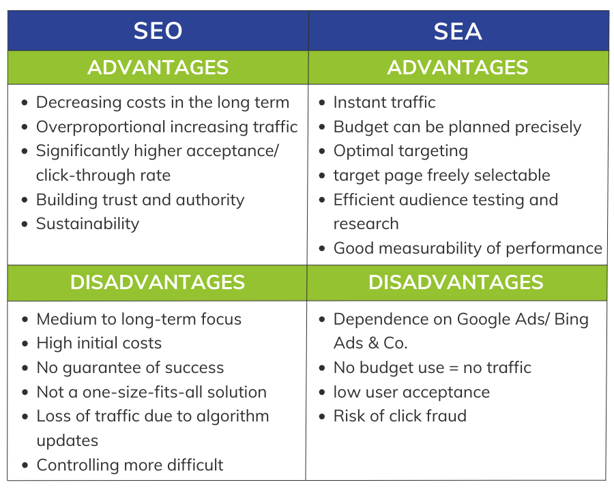
You can find out more about the differences and synergy effects in our article: SEO? SEA? Or both? - How to cleverly use the synergy effects of both channels!
What is The Difference Between B2B SEO and B2C SEO?
Although both the goal of being found online and the tools of the trade are fundamentally the same in B2B and B2C, search engine optimizers face different challenges depending on the industry:Customer Journey
The customer journey in the B2B sector generally differs from the B2C sector in the following ways:
- The customer journey in B2B is significantly longer
- Several people are involved in the purchase decision in B2B (Buying Center)
- The buyer personas are more pointed (no mass market)
In B2B, it is therefore crucial to be present as early as possible in the customer journey and to provide content for everyone involved in the purchasing process.
Requirements for the content
Basically, the same best practices apply when writing B2B texts as for online texts for B2C customers (see also: Writing SEO texts [guide]). And yet there are a few subtleties to consider:
Higher information density
In B2B, we often deal with products that require explanation. Unlike the B2C sector, you do not have to create a need for your product among your customers. The user is already actively looking for a solution to their problem.
Instead, you need to make it clear to your future customers why your service or product is best suited to support them. In B2B, this is achieved less with emotional content and more with information. Even better: (case) studies and facts.
Emotions and storytelling - yes, but the right way
Even if B2B customers crave a lot of information, they are still the same people who watch Netflix and store on Amazon in their private lives.
In other words: B2B customers don't want to have to work their way through soulless deserts of text either.
In this article Texts in B2B: How much humor is allowed? we show you that serious and humorous don't have to be a contradiction in terms.
Likewise, storytelling in B2B is not a taboo. On the contrary: embed your product or service in a story that your buyer persona can relate to - e.g. by letting your existing customers have their say.
Keywords with low search volume
While the search volumes in B2C quickly reach five figures, the search volumes of relevant keywords in B2B often tend towards zero (keywords with low search volumes).
On the other hand, competition is usually much lower. It can therefore be worth optimizing for these keywords with comparatively little effort. After all, the value of a lead is also significantly higher than for many B2C products.
You can find detailed information on the differences in our article: How B2B and B2C SEO differ.
Here is an example of a typical long-tail keyword with a low volume but high potential benefit for the visibility of the core offer:
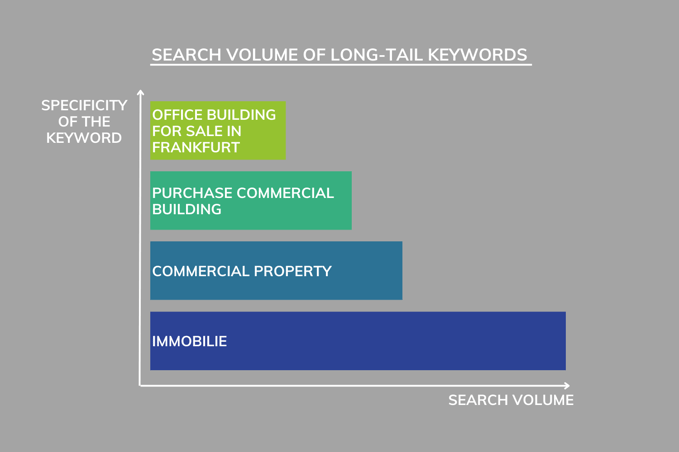
Why is SEO Relevant For Your Business?
Nowadays, search engines are the linchpin when it comes to finding information. Whether you're a teenager or a pensioner, hardly anyone still uses the Yellow Pages to find a suitable service provider.
SEO is therefore relevant for all companies that have their own website. Because the fact is: websites without top rankings on Google are as good as invisible and are rarely or never clicked on. If you don't take advantage of the opportunities offered by an online presence, you will lose potential customers who are already actively searching for a product or service.
Advantages of Search Engine Optimization
What puts many people off is that there is no standard solution for SEO and no guarantee of success. Compared to other online marketing channels, the initial costs are quite high and the first results can sometimes take a few months.
However, if you have the patience and plan for the medium and long term, you can enjoy the various benefits of search engine optimization:
- Sustainability: In contrast to SEA, SEO traffic is more sustainable. If you retire for 3 months and stop spending money on marketing, you will still continue to receive organic visitors.
- Advantages of pull marketing: The customer is already interested and therefore particularly relevant for you as an advertiser.
- Significantly higher acceptance: SEO is not perceived as advertising and tends to lead to significantly more clicks than paid ads (source: study by Sistrix).
- Increase brand awareness through presence on the results pages.
- Early approach in the customer journey: Specific content can be provided for each phase of the customer journey. SEO is therefore one of the most important tools for drawing potential customers' attention to your company at an early stage.
How Does Search Engine Optimization Work?
According to its own information, Google takes over 200 factors into account when determining ranking positions. However, the search engine giant does not disclose exactly what these are. Only a few, such as loading speed, are officially confirmed. The relevance of other factors is controversially discussed within the SEO scene. Other factors are merely speculation.
Google-Rankingfactors
There are many studies on Google's ranking factors (e.g. from Searchmetrics, Backlinko). However, in many cases these are not very meaningful (outdated ranking factors, missing sources) and should be treated with caution.
Ranking factors that are considered relatively reliable include:
- Link authority (number of qualitative and quantitative backlinks to a website)
- Relevance of the content to the search query
- Holistic content
- Loading time
- Keywords in Title Tag
- Length of content
- Dwell time
Google Updates
Search engines regularly improve their algorithms in order to increase the quality of search results. Google makes over 600 such adjustments to its algorithms every year. Most of these changes go unnoticed and are not announced by the search engine company.
Other updates, such as the Bert update, the Phantom update or the Penguin update, have made big waves and led to significant shifts in rankings.
At the same time, Google and Co. are trying to combat search engine spam and manipulation attempts with updates. The penalties even led to exclusion from the index.
You can find an overview of all Google updates from the last 20 years at HubSpot: SEO updates from 2003 to 2021 at a glance
We will keep you up to date on further updates in our blog.
Step by Step to a B2B SEO Strategy
The complexity of search engine optimization has increased significantly in recent years. Simply getting started without first considering the buyer persona, customer journey and marketing goals is risky. After all, a doctor wouldn't just go ahead and operate without first having carried out a thorough medical history and tests.
This is why the SEO strategy is always at the beginning of an SEO journey.
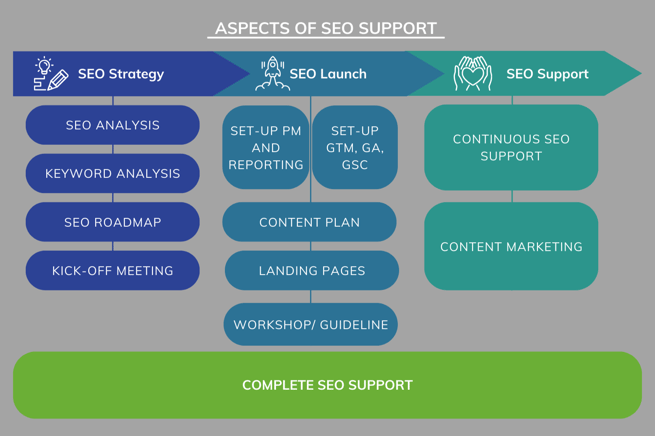
1 Step: Develop a Buyer Persona
In contrast to the B2C sector, we are targeting a niche market in B2B. The target group is very specific. It is therefore essential to know the problems, needs and wishes of the desired customers in detail. This is the only way to address them precisely and minimize wastage.
Further information:
Buyer persona for inbound marketing success
Guide to creating buyer personas
2. Step: SEO Audit
The SEO audit is the heart of every SEO. An SEO audit shows what is already working well, where there are still problems and where there is untapped potential.
By and large, SEO experts look at the following areas in their analysis
- Technology
- Content
- OnPage & Usability and the
backlink structure.
3 Step: Kick-Off Meeting
A close exchange between the SEO service provider and the client is crucial for the success of an SEO project.
In addition to getting to know everyone involved in the project, the results of the SEO audit are presented and measures are discussed at the kick-off meeting.
4 Step: SEO-Roadmap
Once the most important levers have been determined and the processes and division of tasks between the SEO service provider and the client have been clarified, an SEO roadmap provides all project participants with an orientation regarding the time frame.
Diagram: Structure and Process of an Ideal SEO Project
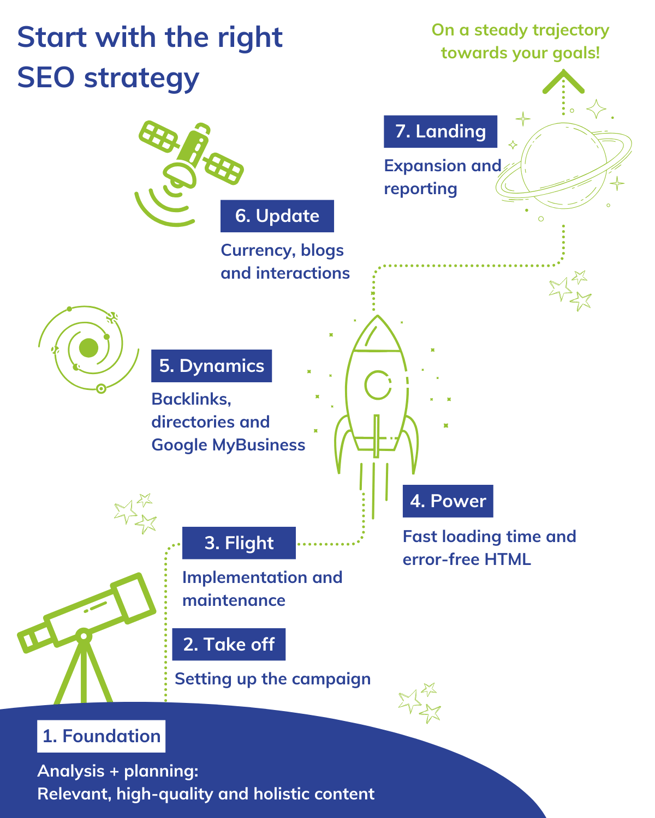
SEO Subdisciplines
Search engine optimization is made up of several sub-disciplines that are more or less interdependent and influence each other.
OnPage
Always keep in mind: Google wants to make the user happy. That is why your website must satisfy the user completely. The first step in optimizing a website should always be to look at the website itself.
Definition and goals of OnPage SEO
On-page optimization refers to technical, content and structural optimizations on a website. The aim of on-page optimization is to optimize a website so that it is easily accessible for search engines.
Among other things, this includes ensuring that a website is indexed at all and is easily accessible for web crawlers. Furthermore, elements such as structured data and keywords help search engines to better understand the content of a page. But measures such as reducing the loading time or good mobile usability, which contribute to better user-friendliness, are also part of on-page optimization.
Measures of OnPage-Optimierung
The following SEO elements play an important role in OnPage Optimization:
- Optimize Google Snippets (Title and Description)
- Placement of keywords Optimization of images (including Alt Tags)
- Internal linking URL design
- Avoiding duplicate content
- Anchor texts Optimization & formatting headlines (H1-H4 heading)
Tools zur OnPage-OptimierungTools for OnPage Optimization
Especially for smaller websites, free tools provide initial important data for managing successful websites with simple means. However, for larger websites, due to their greater complexity, a professional SEO tool quickly becomes worthwhile.
Free tools from Google:
Some extremely powerful tools, foremost among them the Search Console, are provided for free by Google itself.
-
Google PageSpeed Insights (recommendations for reducing loading time)
-
Google's Structured Data Testing Tool (testing of structured data)
-
Google's Mobile Friendly Test (display on mobile devices)
-
Google Search Console (including keyword ranking, indexing issue.
An advantage of Google's tools is that the results always meet the latest requirements of the search engine.
Other free SEO tools:
- technicalseo.com (including Sitemap Generator, robots.txt Test)
- SEOquake (Browser extension, OnPage SEO audit)
- Answerthepublic (Idea generation for content)
- Siteliner (Check duplicate content)
- Sistrix Snippet Generator (Optimize title and description)
With SEO Review Tools you can perform a variety of analyses using 53 free SEO tools.
Paid SEO Tools
With most paid SEO tools, you enjoy an all-inclusive package. Most tools allow you to analyze backlinks, monitor keyword rankings, uncover technical errors, and optimize content. A minor disadvantage of these tools is often their complexity. Especially beginners can quickly feel overwhelmed by the multitude of possibilities. In this case, it is sensible to work with an SEO agency for data analysis.
- Screaming Frog SEO Spider (up to 500 free urls)
- SEMrush
- Sistrix
- Ryte
- Searchmetrics
- Ahrefs
Technical SEO
Technical SEO is, strictly speaking, part of OnPage optimization.
However, the area of technical SEO has become increasingly important in recent years, which is why it is often considered a separate discipline.
Simply put, technical SEO refers to all measures that ensure search engines can easily access a website. Technical SEO is, in a way, the prerequisite for other SEO measures to be effective.
Experience shows that technical SEO is particularly important when websites are newly created or undergoing a website relaunch.
Some of the most important technical SEO optimizations include:
- Regular check for page errors, etc. in the Google Search Console
- Optimize URL structure
- Control robots.txt + upload Sitemap.xml
- Insert breadcrumb menu
- Use structured data
- Limit the length of click paths
- Implement canonical tags
- Check 404 pages
- Set up redirects
- Improve loading speed
- Ensure mobile optimization
- Check text formatting
- Avoid duplicate content
- Monitor hreflang tags for multilingual pages
OffPage
Analogous to OnPage, OffPage refers to all measures that take place outside of a website. Typically, this involves building links to your own website (link building).
For search engines, the number and quality of backlinks are important ranking signals. They are a sign that a page has relevance and authority and is therefore linked by other websites.
A few years ago, it was a promising strategy to buy backlinks from all over the world, regardless of the quality of the linking site and whether the backlink made sense. However, those who still proceed in this way today risk being penalized. Google has become very proficient in assessing the quality of a link. Evaluation criteria include the anchor text, the position of the link, the content relevance, and the authority of the linking site.
Possible link-building measures:
- Publishing guest posts on other websites
- Press work
- Listing in directories
- Link purchase (to be approached with caution)
- Link requests to business partners, suppliers, and customers
- Linking to relevant content for backlinking
- Offering helpful content (e.g., infographics)
- Influencer marketing
- Blog parades
Online Marketing Disciplines with Synergies
Content Marketing
Strictly speaking, content marketing is not a sub-discipline of search engine optimization. Rather, content marketing is a distinct online marketing discipline that has close connections with SEO. Both areas are increasingly merging.
Content marketing is about producing content that pursues a specific marketing goal. The content – such as blog articles, whitepapers, or videos – is consumed and shared by users for its own sake because it is entertaining and helpful.
The goal of content marketing is to generate leads and build reach. A major advantage is that content marketing is suitable for all phases of the customer journey. However, as the graphic below shows, this is a very complex process due to the interplay of various disciplines.
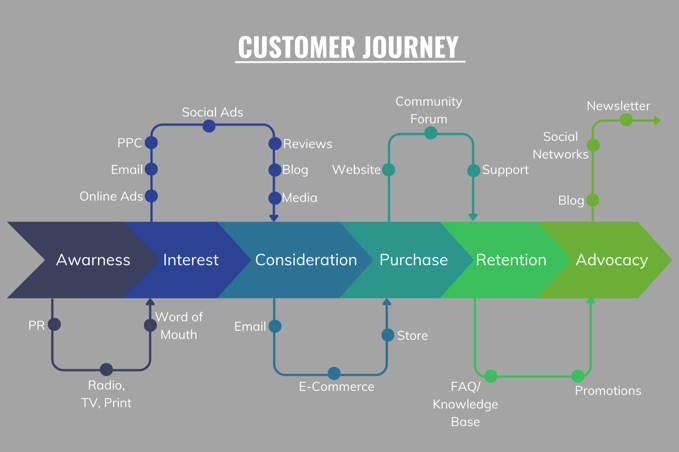
The fact is: SEO without good content does not work anymore these days. The reasons for this are clear:
- Regular new content (freshness) is an important ranking factor. You can do justice to this with content marketing.
- Backlinks are still an important ranking factor. Relevant content with added value is often shared and linked to.
- Google is getting better at recognizing content with added value. Content marketing provides you with target group-oriented content.
Or to put it another way: SEO needs content and content marketing delivers it. Conversely, content marketing needs SEO so that the content can be found at all.
User Experience
With SEO, you succeed in directing traffic to your website. But what follows is just as important. Because you want your users to stay on the site, interact with it and, ideally, become customers. This is where the user experience comes into play.
The term user experience (UX for short) describes the user experience, i.e. the experience that people have with a product. Although user experience is not an official Google ranking factor, one thing is certain: Google can use criteria such as dwell time and bounce rate to assess whether a page meets the expectations of the searcher. If not and users quickly return to the search results page and click on another result, the URL in question will drop in the rankings over time.
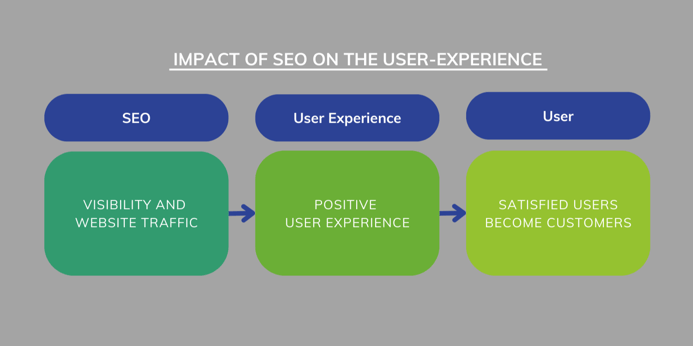
Internationales SEO
International SEO is about being found internationally. This is more complex than it initially sounds. Because if you adopt your local SEO strategy 1:1 for other countries, you will quickly reach your limits.
The rule is: other countries, other customs. This also applies to online marketing. While Google is the undisputed number one search engine in Germany, Yandex is the primary search engine in Russia. There are also cultural, economic and religious influences. There are not only differences in purchasing power, but also in terms of issues such as sustainability or openness to technical innovations. An international market analysis and precise knowledge of the target groups are therefore essential before you expand your offering into other countries.
Furthermore, it is not so easy to transfer the existing keyword strategy 1:1 to other countries. Sometimes there are different terms for one and the same word or search intentions differ. We therefore always recommend getting a native speaker or a local SEO team on board.
With this in mind, one of the most important tasks is to decide on an international domain strategy. Whether you work with directories, subdomains or TLDs (top-level domains) is not a one-size-fits-all decision. Each of the strategies has advantages and disadvantages that need to be carefully weighed up depending on the initial conditions and marketing objectives.
Special Case: Website Relaunch
A website relaunch refers to a new version of the previous website. Possible reasons for the new website are declining traffic or conversion values, outdated technology or design or a change in strategic direction.
A website relaunch is a major project that harbors a number of risks, especially in terms of SEO. There is a high risk of losing rankings and traffic. However, a relaunch also offers the opportunity to increase visibility on the web, sharpen your own positioning and generate more leads.
Careful planning is essential to ensure that the relaunch does not turn into a fiasco - primarily in the area of SEO. An inventory shows what is working well on the old website and what is not. The individual subpages of the website must be checked for their performance and possible keyword cannibalization must be uncovered. The insights gained will help you decide which pages can be added, merged or even deleted.
The following criteria must be observed during a relaunch:
- Create a backup of the old page
- Define buyer persona in advance
- Don't neglect user experience & SEO in favor of the design
- Adjust internal and external links
- Forward URL correctly
- Check HTML codes
- Check whether all pages are accessible
- Adopt title and description
- Implement tracking codes correctly
- Check sitemap and upload to Search Console
- Customize Google Ads ads
- Monitoring and quick adjustments after the live go-live
Website-Relaunch mit dem Growth Driven Design
It happens all too often that a website relaunch turns into a mammoth project and takes up significantly more budget than originally planned. One way to minimize the risk and keep time and budget in check is the growth-driven design approach.
Growth-driven design refers to the continuous further development of your website based on analyzed user data. This involves going through a three-stage process:
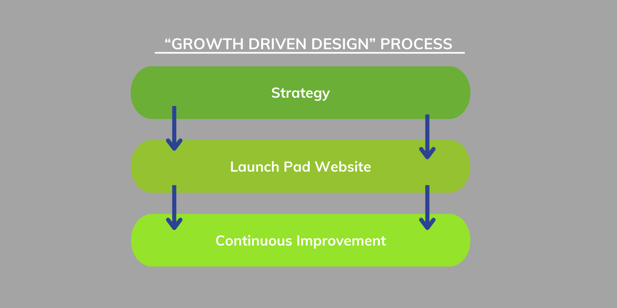
In other words, the primary goal is to launch a new website as quickly as possible and to continue to optimize it after publication. The target is a period of 6 to a maximum of 12 weeks (instead of 3, 6 or even 12 months).
The advantage of this approach is that you collect user data and feedback from real customers at an early stage instead of carrying out your entire relaunch on the basis of assumptions. Instead of a cost-intensive large-scale project, there is a monthly retainer, which puts significantly less strain on your team.
What does SEO cost?
Don't be surprised that only a few SEO agencies quote prices on their website. SEO is not a haircut for which you can calculate the cost in a fairly standardized way. In addition to the size of a website, the level of optimization and the resources available on the customer side also play a role.
As a general rule, the larger and more complex the website, the more work is involved. In general, you can expect hourly rates of €80 upwards from a reputable agency. Do not be put off by such hourly rates. In order to guarantee a high standard of quality, a good agency invests in further training for its employees and in high-quality and expensive SEO tools.
The Right SEO Agency
The success of an SEO project stands and falls with the selection of a suitable SEO provider. Below you will find a number of tips on how to find the right provider for your project:
Criteria for a good SEO agency:
- How quickly is your request answered?
- What is your impression of the agency's website?
- How is the agency's own findability?
- What certificates does the agency have?
- How are the ratings (e.g. on Google or Kununu)?
- How big is the agency? What portfolio is offered?
- Are the employees listed on the website? What
- professional background do they have?
- Does the agency have an active blog?
- Is the owner of the agency or employees active at conferences, with presentations or specialist articles?
Video from Google: to hire a SEO
Maile Ohye, Technical Developper at Google, gives tips on how to find a good SEO partner in this 11-minute video:
B2B SEO with the growth pilots
If you have read this far, you now know about SEO in theory.
If the challenge lies in the practical implementation or a lack of time, we are happy to help with our know-how.
Our growth pilots SEO experts have many years of experience in online marketing and are always up to date with the latest trends.
With our help, you can improve your ranking and increase website traffic and sales.
Why we are the right partner for you:
- Personal and permanent contact persons
- Sustainable working methods and exclusively reputable SEO practices
- Close exchange between SEO and other online marketing disciplines such as Google Ads and social media
- Certified employees and continuous further training
Many years of experience
